Frogs are amphibians, meaning they spend part of their lives in the water and part on land. In the spring, frogs head to their breeding sites, and it’s common to see frogs ‘piggybacking’ on other frogs.
Frogs ride on each other backs to mate in an embrace called ‘amplexus’. In almost all frog and toad species, the males are smaller than the females and are always the ones on top.
Some male frogs migrate to breeding ponds first and wait for females to arrive.
However, other male frogs may hitch a ride to the pond on the back of a female, to ensure that when she arrives at the pond and releases her eggs, he will be in a prime position to fertilize them.
Male Frogs & Toads Mate by ‘Piggybacking’ Females
For most frogs, the breeding is largely triggered by the arrival of rainfall, warmer temperatures, and the increased availability of food.
When the breeding season begins, frogs will migrate to wetlands where they can mate and lay their eggs.
Males will usually arrive first at the breeding sites and call for mates, usually beginning in the early evening.
When the females arrive, they choose their mates depending on individual characteristics of the males’ calls – and head towards the calls of particular males.
The male then grasps the female behind her forelimbs in a tight mating embrace called ‘amplexus’.
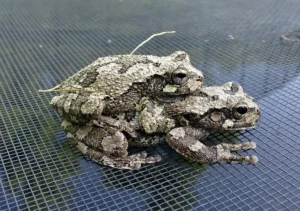
In almost all species, the males are always the ones on top. If you ever see a pair of mating frogs’, you can be sure the one on top is male.
Male frogs’ of many species have differently colored and/or more roughly textured patches on their hands, especially on the insides of their thumbs. These patches of textured skin are called nuptial pads, and help the male frog securely cling to the female during the amplexus embrace.
Occasionally, more than one male will grab onto a female, and a small mating ball, called ‘multiple amplexus’ will form.
Once in the amplexus embrace, the pair will swim around as the female chooses a site to lay her eggs. The female then lays her eggs, and the male releases sperm into the water, to fertilize the eggs externally as the female lays them.
Some Male Frogs Piggy-Back Females Long Before They Reach Their Breeding Sites
Often, male frogs will climb on the back of a female and clasp her tightly as she travels to the pond.
Thus, the female has to carry the male on her back for a considerable distance as she crawls towards the pond where she will spawn.
By staying on her back, the male frog deters any other males from following her once she reaches the pond, ensuring he will be the one to fertilize her eggs.
Sometimes, Male Frogs May Grab Onto the Wrong Frog
Many toad and frog species often share breeding ponds, and misdirected amplexus may occur.
Male frogs or toads may mistakenly grab onto incompatible frogs/toads, and attempt to mate with them – this is known as “misdirected courtship”.
The misdirection is caused by a mistake during species recognition.
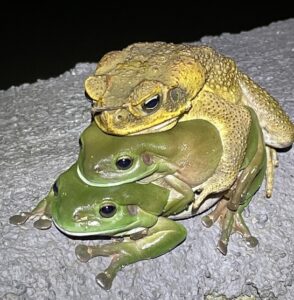
Male frogs and toads have been observed attempting to mate with incompatible species, other males, dead female toads/frogs, and even with objects or non-amphibian species.
When a male frog or toad is mounted by another male, it will produce a vibration in the area of its chest where it’s being clasped and emits a squeak (known as a release call) and the offending male will immediately let go.
When a female frog has an unwanted amplexus forced upon her, she may react by emitting a release call and rolling over to get the male to release her.
If this fails, she may may react by not releasing eggs, or releasing an amount just enough to get the male off her back.
How Long Do Frogs Stay In Amplexus?
In general, most male and female frogs stay in amplexus for a relatively short time.
For example, researchers studying the breeding activity of the olive frog (Rana adenopleura) of subtropical Taiwan found that amplexus lasted less than 11 minutes on average.
Of this time, 8 minutes were spent on pre-oviposition activity, and oviposition only lasted 3 minutes.
That said, it is important to note that amplexus duration varies greatly among frog species. It may last for a few minutes, hours, days, or even months, depending on the species.
Not All Frogs Mate in the Same Way
There are more than 7,000 known species of frogs in the world.
For most of species, the most common type of amplexus is where the male grasps the female around the torso with his forelimbs and fertilizes the eggs as they emerge.
However, there are seven distinct frog mating positions known.
Here are a few examples:
1. Common Rain Frog (Breviceps adspersus)
Common Rain Frogs found in southern Africa have a round body and short arms.
Their round body enables them to survive them to survive being buried underground during dry periods without losing too much water.
However, it presents a challenge when it comes to mating as the male’s short arms can’t reach around the female.
To solve this problem, the male secretes a kind of glue to stick himself to the female. This position is known as “glued amplexus”.
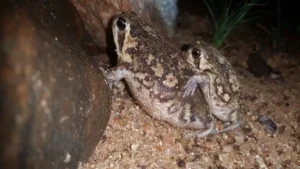
The mating pair then burrow backward into the soil until they reach the chamber the female has dug below the soil surface.
The female lays her eggs, and the male fertilizes them as they are being laid.
These eggs then hatch into young frogs that are morphologically similar to the adults, skipping the tadpole stage. This is known as ‘direct development.’
2. Whipping Frogs (Polypedates)
Many Whipping frog species in eastern and southern Asia rely on heavy rains to breed and need to give their tadpoles enough time to develop before the puddle dries out.
In these species, multiple frogs often mate at once – typically one female and multiple males.
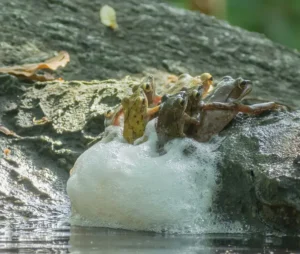
When the eggs are laid, they are whipped up into a foam nest and attached to vegetation or rocks above temporary pools of fresh water.
When the tadpoles hatch, they will wriggle down the foamy secretion and plop into the water below.
3. Bombay Night Frog (Nyctibatrachus humayuni)
Bombay night frogs are native to the Western Ghats of southern India.
On nights during the monsoon season, male Bombay night frogs come out and maintain a territory on a twig or leaf overhanging a stream and call for females.
The females move between male territories before choosing a male to mate with.
The male then mounts the female in a loose form of amplexus, called a “dorsal straddle”.
During this process, the male rests above the female by holding on to vegetation above the female and lays his abdomen on her lower dorsum.
From there, the male releases sperm onto the female’s back, and gets off her back.
A few seconds later, the female lays her eggs, and the sperm trickles down her back and onto the eggs to fertilize them – without any further physical contact with the male.
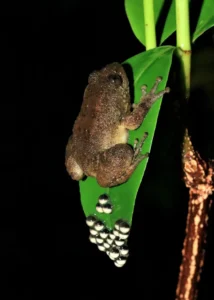
Researchers believe this unique mating strategy may function as a means to avoid falling during the mating process.
Featured image credit: Girish Gowda, CC BY-SA 4.0
Common Questions
Why do frogs hug each other? Frogs hug each other to mate in an embrace called ‘amplexus’. In most frog species, the males are smaller than the females and are always the ones on top – clinging to the larger female.
Sources:
Chuang MF, Bee MA, Kam YC. Short amplexus duration in a territorial anuran: a possible adaptation in response to male-male competition. PLoS One. 2013 Dec 10;8(12):e83116. doi: 10.1371/journal.pone.0083116. PMID: 24340089; PMCID: PMC3858373.
Attila Hettyey, Sandra Baksay, Balázs Vági, Herbert Hoi. Counterstrategies by female frogs to sexual coercion by hetero specifics, Animal Behaviour, Volume 78, Issue 6, 2009, Pages 1365-1372, ISSN 0003-3472, https://doi.org/10.1016/j.anbehav.2009.09.006.
François Brischoux, Léa Lorrain-Soligon, Anuran swingers: misdirected mating attempts occurred early during anuran diversification, Biological Journal of the Linnean Society, 2023; blad108, https://doi.org/10.1093/biolinnean/blad108
Vassilieva, A. B., Galoyan, E. A., & Poyarkov, N. A. (2013). “Rhacophorus vampyrus” (Anura: Rhacophoridae) Reproductive Biology: A New Type of Oophagous Tadpole in Asian Treefrogs. Journal of Herpetology, 47(4), 607–614. http://www.jstor.org/stable/43287397


